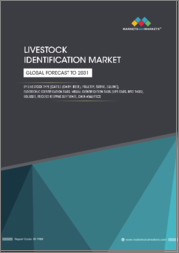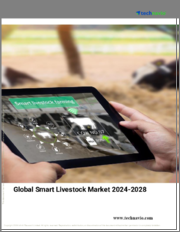
|
시장보고서
상품코드
1708070
가축 식별 시장 : 현황 분석과 예측(2024-2032년)Livestock Identification Market: Current Analysis and Forecast (2024-2032) |
||||||
축산업계가 질병을 감지하고 정부 규정을 준수하는 데 더욱 집중함에 따라 가축의 특성을 식별하는 시장이 확대되고 있습니다. 이 시장은 가축의 건강을 보호하고, 공급망의 효율성을 향상시키며, 가축의 생애를 처음부터 끝까지 일관되게 관리할 수 있는 기술로 구성되어 있습니다. 축산업계가 가축 추적을 필요로 하는 이유는 사람들이 가축으로부터 더 많은 식량을 얻기를 원하고, 새로운 기술이 더 나은 식별을 돕고, 정부가 완전한 가축 추적 기록을 요구하고 있기 때문입니다.
가축 식별 시장 규모는 효율적인 가축 관리를 위한 RFID 및 IoT 기반 추적의 채택 증가, 추적성 및 질병 관리를 위한 엄격한 정부 규제로 인해 예측 기간 중 CAGR 7.1%의 견고한 성장을 보일 것으로 예상됩니다. 향후 수년간 아시아태평양이 가장 빠른 속도로 시장을 확대할 것으로 예상됩니다. 중국, 인도, 호주, 일본의 육류 시장 수요는 가축 수 증가에 따라 확대될 것입니다. 예를 들어 2023년 인도는 세계 최대 소 재고를 보유할 것으로 예상되며, 브라질과 중국이 그 뒤를 이어 2023년 인도의 소 재고는 3억 750만 마리로 전 세계 소 재고의 약 33%를 차지할 것으로 보고되고 있습니다. 확장하는 축산 부문과 가축 추적 소프트웨어에 대한 지식을 습득하는 부동산 소유주들이 구매 희망자들을 부추기고 있습니다. 예측 기간 중 중국과 인도는 이 지역에서 가장 빠르게 성장하는 국가입니다.
기술별로 시장은 무선 주파수 식별, 바코드 식별, 세계 포지셔닝 시스템, 기타로 분류됩니다. 이 중 무선 자동 식별은 높은 CAGR로 성장하고 있으며, RFID 기술은 조직이 농업 시스템에서 정확한 실시간 사료 추적과 간소화된 운영을 필요로 하므로 시장에서 강력한 추진력을 얻고 있습니다. 무선 주파수 식별 시스템은 목장주가 가축의 작업을 자동으로 관찰하고 정리하여 직원의 업무 부담을 줄이고 인적 오류를 방지하는 데 도움이 될 수 있습니다. 규제 당국이 공중 보건을 보호하고 가축의 수출을 허용하기를 원하므로 공식적인 가축 추적 규칙은 RFID의 사용을 늘리는 데 도움이 되었습니다. 경제적인 RFID 태그의 개발과 센서의 품질이 향상됨에 따라 이 기술은 농장과 가축 생산 시설에서 가축 추적에 쉽게 사용할 수 있게 되었습니다.
최종사용자별로 가축 식별 시장은 소, 돼지, 가금류, 양 및 염소로 구분됩니다. 소 부문은 예측 기간 중 높은 CAGR을 기록했습니다. 가축 식별 시장의 소 부문은 식품 안전 추적 및 질병 관리 요건에 대한 수요 증가가 성장의 원동력이 되고 있습니다. 각국 정부는 소 결핵 및 구제역과 같은 질병의 확산을 억제하고 가축의 건강 모니터링을 개선하기 위해 추적 시스템을 의무화하여 가축의 건강 모니터링을 개선하고 있습니다. 소비자들은 도덕적으로 생산된 육류와 유제품을 원하고, RFID 추적 시스템 및 기타 스마트 기술이 농작업에 도움을 주면서 시장은 계속 성장하고 있습니다. 낙농가와 비즈니스 리더들 수요 증가로 인해 가축 생산을 추적하고 관리할 수 있는 더 나은 시스템이 요구되고 있습니다.
가축 식별 산업 시장 도입에 대한 더 나은 이해를 위해 시장은 북미(미국, 캐나다, 기타), 유럽(독일, 영국, 프랑스, 프랑스, 스페인, 이탈리아, 기타), 아시아태평양(중국, 일본, 인도, 인도, 호주, 기타), 기타 지역의 세계 존재를 기반으로 분석되고 있습니다. 분석되었습니다. 아시아태평양은 가축 사육두수와 육류 및 유제품에 대한 수요가 증가하고 있으며, 지역 당국의 추적 시스템 요구로 인해 가축 식별 시스템에서 강력한 성장세를 보이고 있습니다. 일부 국가, 특히 중국, 인도, 호주, 뉴질랜드는 식품 안전과 동물의 건강을 점검하기 위해 엄격한 법률을 채택하여 선도하고 있습니다. 농가과 업계 관계자들이 RFID 태그와 사물인터넷 기술을 선택하는 이유는 이러한 시스템이 가축을 더 똑똑하고 더 잘 관리할 수 있도록 도와주기 때문입니다. 아이러니하게도 이 지역 시장 확대는 두 가지 다른 힘에 의해 이루어지고 있습니다. 하나는 농업에서 디지털 기술의 사용 확대와 정부의 동물 식별 장비에 대한 재정적 혜택입니다. 중국과 인도는 세계 최고의 육류 및 유제품 생산국이기 때문에 추적 툴에 대한 시장 수요가 점점 더 강해지고 있습니다. 호주의 확고한 가축 수출과 뉴질랜드의 유제품 생산은 이 시장 개발을 촉진하고 있습니다. 아시아태평양의 다양한 기술 스타트업들은 AI 모니터링을 통해 가축을 추적하고 블록체인을 사용하여 공급망 기록 관리를 위한 새로운 솔루션을 개발하고 있으며, APAC 전역의 가축 식별 부문은 보다 엄격한 식품 안전 규정과 윤리적 제품 구매자의 기대치가 높아짐에 따라 제품 구매자의 기대치가 높아짐에 따라 APAC 전역의 가축 식별 부문은 계속 확대될 것으로 보입니다.
이 시장에서 사업을 운영하는 주요 기업에는 Datamars, Allflex Livestock Intelligence(Merck Animal Health), Nedap N.V., Shearwell Data Ltd., CAISLEY International GmbH, Kupsan Tag Company Ltd., Luoyang Laipson Information Technology Co.Ltd., Y-Tex Corporation, Leader Products, OMNIA Technologies Pvt. Ltd. 등이 있습니다.
세계의 가축 식별 시장에 대해 조사했으며, 시장의 개요와 기술별, 최종사용자별, 지역별 동향 및 시장에 참여하는 기업의 개요 등을 제공하고 있습니다.
목차
제1장 시장 서론
제2장 조사 방법 또는 가정
제3장 개요
제4장 시장 역학
- 촉진요인
- 기회
- 억제요인
- 동향
- PESTEL 분석
- 수요측 분석
- 공급측 분석
제5장 가격 분석
- 지역 가격 분석
- 가격에 영향을 미치는 요인
제6장 세계의 가축 식별 시장 매출(100만 달러), 예측(2022-2032년)
제7장 기술별 시장 분석
- 무선 주파수 식별
- 바코드 식별
- GPS(Global Positioning System)
- 기타
제8장 최종사용자별 시장 분석
- 소
- 돼지
- 가금
- 양·염소
제9장 지역별 시장 분석
- 북미
- 미국
- 캐나다
- 기타
- 유럽
- 독일
- 영국
- 스페인
- 프랑스
- 이탈리아
- 기타
- 아시아태평양
- 중국
- 인도
- 일본
- 호주
- 기타
- 기타 국가
제10장 밸류체인 분석
제11장 경쟁 구도
- 경쟁 대시보드
- 경쟁 시장 포지셔닝 분석
- Porter's Five Forces 분석
제12장 기업 개요
- Datamars
- Allflex Livestock Intelligence(Merck Animal Health)
- Nedap N.V.
- Shearwell Data Ltd.
- CAISLEY International GmbH
- Kupsan Tag Company Ltd.
- Luoyang Laipson Information Technology Co., Ltd
- Y-Tex Corporation
- Leader Products
- OMNIA Technologies Pvt. Ltd.
제13장 두자어와 가정
제14장 부록
KSA 25.05.02The market for identifying livestock properties grows as the animal industry focuses more on detecting diseases and meeting government rules. This market consists of technologies that help operators maintain constant control of livestock from their life start to finish while protecting animal health and improving supply chain efficiency. The livestock industry needs more animal tracking because people want more food from animals, plus new technology helps make identifications better, plus governments require complete animal tracking records.
The Livestock Identification Market is expected to grow at a robust CAGR of 7.1% during the forecast period, owing to the strict government regulations for traceability and disease control, along with the growing adoption of RFID and IoT-based tracking for efficient herd management. In the coming years, the Asia Pacific region will expand its market at the fastest rate. The meat market demand in China, India, Australia, and Japan grows as their livestock numbers rise. For instance, India had the largest cattle inventory in the world in 2023 followed by Brazil and China. India's cattle inventory was reported at 307.5 million head in 2023, accounting for roughly 33% of the world's inventory. The expanding livestock sector, together with property owners gaining knowledge about livestock tracking software drives prospective buyers. China and India will be the fastest-growing countries in the region during the forecast period.
Based on Technology, the market is categorized into Radio Frequency Identification, Barcode Identification, Global Positioning System, and Others. Among these, Radio Frequency Identification is growing with a significant CAGR. RFID technology gains strong market momentum because organizations need precise live feed tracking and streamlined operations in their farming system. The radio frequency identification system helps ranchers observe and organize their livestock operations automatically to reduce staff workload and prevent human mistakes. Official animal tracing rules help increase the use of RFID as regulators want to protect public health and enable animal export. Developments in economical RFID tags and enhanced sensor quality make the technology easier to use for livestock tracking at farms and animal production facilities.
Based on End User, the Livestock Identification market is divided into Cattle, Swine, Poultry, and Sheep & Goats. The Cattle segment registered a significant CAGR during the forecast period. The cattle segment of the Livestock Identification Market experiences growth driven by growing demands for food safety tracking and disease control requirements. Governments in all nations are making tracking systems mandatory to control the spread of diseases like Bovine Tuberculosis and Foot-and-Mouth Disease, which improves livestock health monitoring. The market keeps growing because consumers want morally-produced meat and dairy products and because RFID tracking systems and other smart technology help farming operations. Rising demand from farmers and business leaders makes them want better systems to track and manage their cattle production.
For a better understanding of the market adoption of the Livestock Identification industry, the market is analyzed based on its worldwide presence in countries such as North America (U.S.A., Canada, and Rest of North America), Europe (Germany, United Kingdom, France, Spain, Italy, and Rest of Europe), Asia-Pacific (China, Japan, India, Australia, and Rest of Asia-Pacific), Rest of World. The Asia-Pacific region shows strong growth in its livestock identification system because animal numbers and meat-dairy demand are rising, plus regional authorities require tracking systems. Several nations, especially China, India, Australia, and New Zealand, lead by adopting harsh laws to check food safety and animal wellness. Farmers and industry members select RFID tags and Internet of Things technology because these systems help them run their herds smarter and better. Ironically enough, market expansion in this region comes from two different forces. One comes from increased use of digital technology in agriculture and the other develops due to financial incentives provided by the government on animal identification equipment. China and India stand as leading meat and dairy producers globally so the market demand for tracking tools keeps growing stronger. The established livestock exports from Australia and dairy production in New Zealand drive this market's development. Various technology startups in APAC create new solutions that use AI monitoring to track livestock, plus blockchain for supply chain recordkeeping. The livestock identification sector across APAC will keep expanding because of stricter food safety rules and rising ethical product buyer expectations.
Some of the major players operating in the market include Datamars, Allflex Livestock Intelligence (Merck Animal Health), Nedap N.V., Shearwell Data Ltd., CAISLEY International GmbH, Kupsan Tag Company Ltd., Luoyang Laipson Information Technology Co., Ltd., Y-Tex Corporation, Leader Products, and OMNIA Technologies Pvt. Ltd.
TABLE OF CONTENTS
1.Market Introduction
- 1.1. Market Definitions
- 1.2. Main Objective
- 1.3. Stakeholders
- 1.4. Limitation
2.Research Methodology Or Assumption
- 2.1. Research Process of the Livestock Identification Market
- 2.2. Research Methodology of the Livestock Identification Market
- 2.3. Respondent Profile
3.Executive Summary
- 3.1. Industry Synopsis
- 3.2. Segmental Outlook
- 3.2.1. Market Growth Intensity
- 3.3. Regional Outlook
4.Market Dynamics
- 4.1. Drivers
- 4.2. Opportunity
- 4.3. Restraints
- 4.4. Trends
- 4.5. PESTEL Analysis
- 4.6. Demand Side Analysis
- 4.7. Supply Side Analysis
- 4.7.1. Merger & Acquisition
- 4.7.2. Investment Scenario
- 4.7.3. Industry Insights: Leading Startups and Their Unique Strategies
5.Pricing Analysis
- 5.1. Regional Pricing Analysis
- 5.2. Price Influencing Factors
6.Global Livestock Identification Market Revenue (USD Mn), 2022-2032F
7.Market Insights By Technology
- 7.1. Radio Frequency Identification
- 7.2. Barcode Identification
- 7.3. Global Positioning System
- 7.4. Others
8.Market Insights By End User
- 8.1. Cattle
- 8.2. Swine
- 8.3. Poultry
- 8.4. Sheep & Goats
9.Market Insights By Region
- 9.1. North America
- 9.1.1. USA
- 9.1.2. Canada
- 9.1.3. Rest of NA
- 9.2. Europe
- 9.2.1. Germany
- 9.2.2. United Kingdom
- 9.2.3. Spain
- 9.2.4. France
- 9.2.5. Italy
- 9.2.6. Rest of Europe
- 9.3. Asia Pacific
- 9.3.1. China
- 9.3.2. India
- 9.3.3. Japan
- 9.3.4. Australia
- 9.3.5. Rest of APAC
- 9.4. Rest of World
10.Value Chain Analysis
- 10.1. Marginal Analysis
- 10.2. List of Market Participants
11.Competitive Landscape
- 11.1. Competition Dashboard
- 11.2. Competitor Market Positioning Analysis
- 11.3. Porter Five Forces Analysis
12.Company Profiled
- 12.1. Datamars
- 12.1.1. Company Overview
- 12.1.2. Key Financials
- 12.1.3. SWOT Analysis
- 12.1.4. Product Portfolio
- 12.1.5. Recent Developments
- 12.2. Allflex Livestock Intelligence (Merck Animal Health)
- 12.3. Nedap N.V.
- 12.4. Shearwell Data Ltd.
- 12.5. CAISLEY International GmbH
- 12.6. Kupsan Tag Company Ltd.
- 12.7. Luoyang Laipson Information Technology Co., Ltd
- 12.8. Y-Tex Corporation
- 12.9. Leader Products
- 12.10. OMNIA Technologies Pvt. Ltd.
















